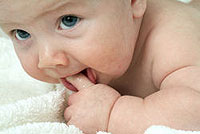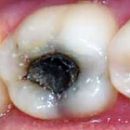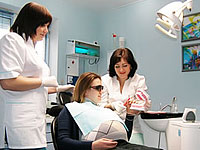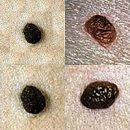As a future mother can affect the quality of the teeth in the child? When and what teeth begin to teething in children? What are the deviations when teething teething? Answers you will find in this article.
Content
 The problem of teething in the baby is incredibly relevant among young mothers, so we cannot bypass it.
The problem of teething in the baby is incredibly relevant among young mothers, so we cannot bypass it.
Event This may not have caused such a tension if it was not accompanied by a clear change in the behavior of a child, which sometimes just shocks unprepared parents.
So what actually happens to your baby, what to expect from these difficult months, what actions to take and when, finally, all this will end, - on these issues we tried to find answers from very competent sources, accompanying them some interesting additions from sources Not very competent, but no less important - recommendations «Being» Parents.
History of teeth
The history of your baby's teeth began long before his birth. In many ways, their future state is predetermined genetically. Of course, if all the wonderful teeth are in your family, you can expect the same pleasant surprise and from your baby. But it would be too easy if on it all stopped.
Nature arranged so that even before the birth of the child, the mother can affect the formation of his teeth. And in any direction. Already on the fifth-sixth week of pregnancy in the jaws of the fetus, dental kidneys are laid, the dental enamel begins between the third and sixth month. And this mechanism depends on the diet of a pregnant woman in which there must be a sufficient amount of minerals and vitamins.
For a future mother
- Make sure that calcium and fluorine-containing products are present in your diet (Calcium sources - milk and fermented milk products, leaf cabbage, broccoli, young turnip; fluoride sources - non-fat seafrine, spinach, green tea).
- Provide a future child with all the necessary vitamins and trace elements (Eat fresh vegetables and fruits, dried fruits, greens, drink natural juices, take specially selected vitamin complexes).
- Use only clean water, use water filters.
- Watch out for the condition of your teeth, limit yourself in sweets and sweet drinks. If necessary, immediately treat your teeth, even during pregnancy, warning the dentist about your position. The most optimal for the treatment and removal of teeth is considered period from 4 to 6 month of pregnancy.
- Clean your teeth regularly and rinse your mouth after each meal. Choose a suitable toothbrush (optimal option - brush «medium» (medium hardness), with bleeding gums, use soft («Soft»). Try to change the brush every 3 months.
- If you need antibiotics during pregnancy - do not use tetracycline (it can cause a change in the color of the infant teeth).
Teething
In total dairy teeth in the child will be with time 20, 10 on each jaw, but they will all gradually shift to about two years.
 We are now more interested in the order of dismantling the first of them, that is, the kid is up to the year. The first milk teeth appear at 6-8 months. Usually the procedure for teething such.
We are now more interested in the order of dismantling the first of them, that is, the kid is up to the year. The first milk teeth appear at 6-8 months. Usually the procedure for teething such.
In the period between 6 and 8 months of life, the central cutters of the lower jaw appear, which are located in the very center of the lower jaw.
Then the central upper incisors appear, which are also located in the center of the tooth row.
By 8-12 months - the upper side cutters located near the central.
Then the same teeth appear on the lower jaw.
Usually by the year, the child should normally have 8 teeth, but parents should know that the presence of 2-4 or the presence of 10 teeth at this age is not a serious deviation. Too early or later the appearance of teeth can be determined by heredity. You can worry only if the child's teeth appeared until the year. In this case, the children's dentist requires consultation. Sometimes doctors make an X-ray to determine the condition of unrealted teeth.
Some deviations for teething teething
Timely, in a certain sequence, the growth of the teeth testifies to the normal development of the body of the kid. This is a physiological process and it is in direct connection with the general state of the child's health. But consider some atypical situations that indirectly can talk about the presence of pathology. However, only indirectly. Once again, we will discuss that only a thorough study can confirm or refute these assumptions.
- Delay in the timing of teething (longer than 1-2 months from the norm) may be a consequence of rickets, an infectious disease, a continuous disorder of the intestinal function and changes in metabolism.
- Early teething (previously 1-2 months to normal) - may indicate endocrine disorders.
- Violation of the sequence, the absence of a tooth can also be the result of some abnormalities in the health of the child (there are isolated cases when there are no teeth of the teeth) or be a consequence of the maternal diseases during pregnancy.
- The teething of the tooth outside the dental arc may be caused by the wrong position of the tooth axis (horizontal or oblique).
- Improper formation of the tooth itself - size, shape, position, color, lack of enamel coating and t.D. The reasons for these phenomena should be analyzed by a specialist.
- The appearance of teeth before birth. Such situations are extremely rare. Such teeth interfere with the child to suck the mother's chest, usually remove them.









